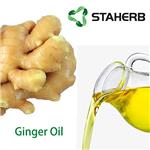Chemical Properties
Obtained by steam distillation of dried, ground rhizomes The yield is approximately 0 25 to 1.2% The oil has a warm, spicy, aromatic odor; the oil tends to thicken and darken on exposure to air The oil lacks the pungency of the other derivatives.
Chemical Properties
Ginger oil and ginger oleoresin are produced from the ginger plant Zingiber
officinale Roscoe (Zingiberaceae).
Ginger oil is produced by steamdistillation of dried, ground rhizomes. It is a light
yellow to yellow liquid with the aromatic, persistent odor of ginger, but lacking the
pungency usually associated with ginger.The citrus note of ginger oil is produced
by citral.
d
2525 0.871–0.882; n
20D 1.4880–1.4940; α
20D ?45 ° to ?28 °; saponification number:
max. 20; soluble in ethanol, solutions are usually turbid.
The major components of the oil are β-sesquiphellandrene and zingiberene.
Physical properties
Ginger oil is a light-yellow to yellow liquid It is soluble in most fxed oils and in mineral oil It is soluble, usually with turbidity, in alcohol, but it is insoluble in glycerin and propylene glycol.
Occurrence
Found in the plant Zingiber officinale Roscoe (Fam. Zingiberaceae) (Guenther, 1952).
Uses
Flavor in foods and beverages.
Preparation
By steam distillation of the dried ground rhizomes (Fenarolis' Handbook of Flavor Ingredients, 1971).
Definition
Extractives and their physically modified derivatives. Zingiber officinale, Zingiberaceae.
Essential oil composition
Main constituents include sesquiterpenes, farnesene, methylheptenone, cineol, borneol, geraniol and
linalool.
General Description
Ginger oil generally contains sesquiterpene hydrocarbons such as zingiberene,
ar-curcumene, β-bisabolene and β-sesquiphellandrene and monoterpenes such as geranial, neral and camphene.
Biochem/physiol Actions
Taste at 30 ppm
Safety Profile
Moderately toxic by
ingestion and intraperitoneal routes. A skin
irritant. Mutation data reported. When
heated to decomposition it emits acrid
smoke and irritating fumes.





